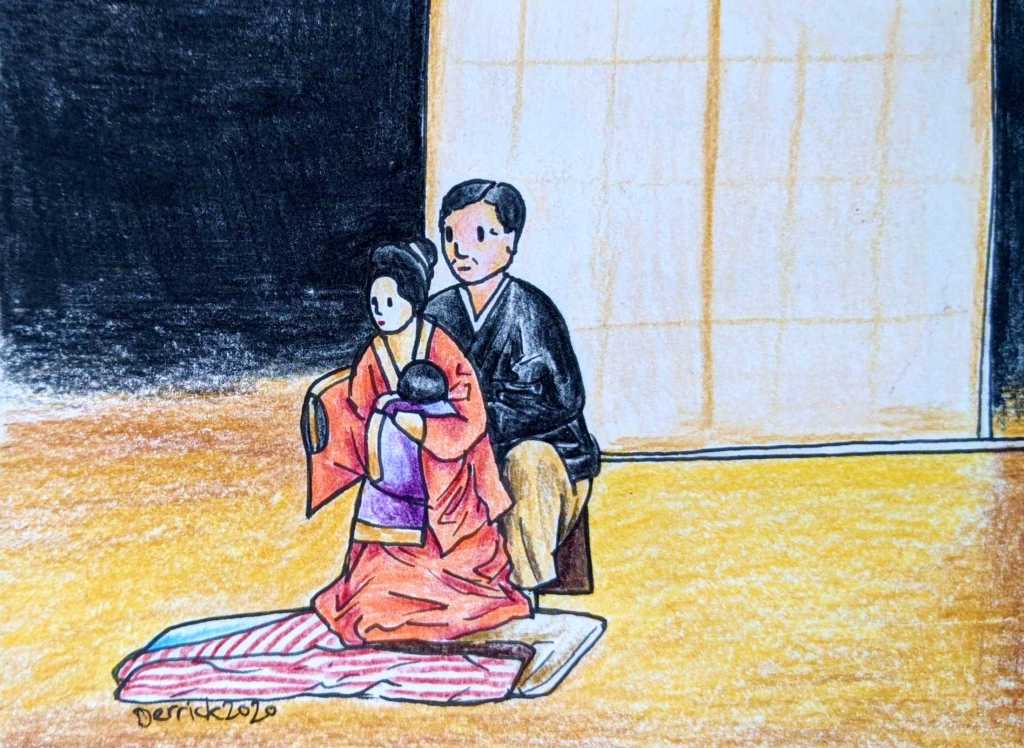One of Tokyo’s most unique art forms is the puppetry performance at Hachioji Kuruma Ningyo Puppet Theatre. The style is characterised by a puppeteer on a small wooden cart (rokuro kuruma) controlling a single large puppet. Controlling the individual arms, legs and head with their own limbs, whilst moving around the stage on the cart gives the puppet a fluid, dynamic range of motion.
Developed in Tokyo in the 19th century, this puppet theatre is still in the hands of the family who invented it, and has expanded from its home in Hachioji, Tokyo, to stages around the world.

Origins Of Hachioji Kuruma Ningyo
The Hachioji Kuruma Ningyo style of puppetry began in 1872, and was derived from the bunraku puppetry style which had been popular since the early 17th century. The style was originally developed by Nishikawa Koryu (1824-1897), and has stayed in the family ever since. In the city of Hachioji in greater Tokyo, the theatre is the only one of its kind.
The theatre is currently run by the grandmaster Nishikawa Koryu V, the 5th in his family line with the same name. Now in his 60s, he has been performing with the puppets since the age of 13, and his son is also learning how to perfect the art of puppetry. Today, the theatre has moved to more and more international locations, performing in Europe, South America, and the USA.
The stories performed by the puppeteers depict events from Japan’s Edo period (Tokugawa period, 1603 – 1868), as well as recreations of classic Japanese literature, retaining these traditional stories since the theatre’s original opening.
Some stories include The Tale of Genji, an 11th century book which follows the handsome courtier Genji, and his pursuits of love in aristocratic Japan. Kuzunoha is the story of a fox in human form, whose identity is revealed as a kami, a Shinto spirit. An example of an Edo period story is Tōkaidōchū Hizakurige, the misadventures of two travellers who travel between Edo and Kyoto, published in 12 volumes between 1802 and 1822.

Performance Of Hachioji Kuruma Ningyo
The precursor to Hachioji Kuruma Ningyo, Bunraku, uses similar sized puppets. At about one metre (39 inches) tall, Bunraku requires three puppeteers to control each puppet. By contrast, the similar-sized puppets in Hachioji Kuruma Ningyo require a single puppeteer. The puppets are important historic artefacts in their own right, with some examples being upwards of a century old. Each one weighs about 6kg (13lbs), and is made of cypress wood.
They are hand-painted, with the faces typically painted in white, black and red. Their costumes are carefully designed yukatas and kimonos, whilst the puppeteers perform in black cowls to hide themselves from view. The musical accompaniment is performed by a shamisen (a traditional 3-stringed instrument) and a singer. The music serves to add extra emotional touches to the story, whilst a narrator provides the voice work for each performance.
Recognition And Cultural Impact
Hachioji Kuruma Ningyo was designated an Intangible Cultural Asset in 1962 by the city of Tokyo, to recognise the art form’s importance. In 1996, it was awarded the status of Intangible Folk Cultural Property, to recognise its historic and artistic value. The puppets are even featured on some of the manhole covers of the Hachioji area, their beautiful colourful designs brightening up the streets underfoot.

***
Hachioji Kuruma Ningyo is one of Tokyo’s most unique artistic contributions, combining historical storytelling with specialised puppetry techniques. The cypress dolls come to life as the puppeteers express the emotions of the story, using their freedom of movement and the reactions of audience reactions to inhabit the characters, and make the puppets feel almost human.
Starting as a family business, Hachioji Kuruma Ningyo has grown to be appreciated by puppetry fans across the world, whilst also sharing and teaching the world about Japanese folk stories.
One thought on “Hachioji Kuruma Ningyo – Discovering Tokyo’s Puppets On A Cart”
Comments are closed.